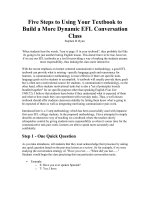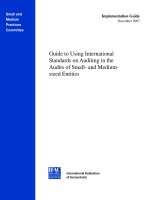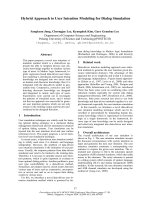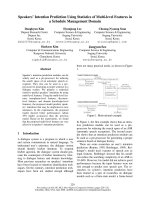Factors affecting fast food consumers’ intention to use menu labeling in Klang Valley, Malaysia
Bạn đang xem bản rút gọn của tài liệu. Xem và tải ngay bản đầy đủ của tài liệu tại đây (396.85 KB, 7 trang )
© All Rights Reserved
*Corresponding author.
Email:
International Food Research Journal 20(4): 1799-1805 (2013)
Journal homepage:
Delvarani, S., Ghazali, H. and
*
Othman, M.
Department of Food Service and Management, Faculty of Food Science and Technology,
Universiti Putra Malaysia, 43400 Serdang, Selangor, Malaysia
Factors affecting fast food consumers’ intention to use menu labeling in
Klang Valley, Malaysia
Abstract
Menu labeling is an attempt to educate consumers about the nutrition value of the foods. The
importance of using menu labeling has been highlighted in many studies in the past. Although
public health programs are educating public on obesity but still this phenomenon is a serious
problem in Malaysia. This study identied factors that inuence intention to use menu labeling
among fast food consumers in Malaysia. The research was conducted among 395 adults in
Klang Valley. Respondents completed a self-administrative questionnaire which was adapted
from previous studies. Results revealed that attitude, subjective norms and perceived behavioral
control had statistically signicant positive association with intention and each was signicant
predictors of intention to use menu labeling and together explained 41% of its variance. The
most effective factor was attitude, followed by subjective norms and perceived behavioral
control. The outcomes of this study suggested that nutritional knowledge of consumers does
not have effect on consumer’s intention to use menu labeling; therefore nutritional knowledge
of fast food consumers must be improved. Fast food restaurants have to put more effort on
encouraging customers to use menu labeling by making the label more accessible and in a user
friendly format.
Introduction
Menu labeling is a list of nutritional information at
restaurants which typically reports calories, saturated
fat, sodium and carbohydrates. Previous studies have
veried that consumers underestimate the calorie
especially in high calorie foods (Burton et al., 2006;
Chandon and Wansink, 2007; Bates et al., 2011).
Therefore menu labeling has been designed as a health
education tool to help consumers to achieve healthier
diet and better overall health. Food eaten outside,
and in particular, fast foods, are high in calories.
(Bassett et al., 2008). Obesity, and subsequently,
cardiovascular diseases, cancers, diabetes and other
diet related diseases are the consequences of such an
unhealthy diet (Norimah and Kather, 2003; Satia and
Galanko, 2007). According to Ministry of Health of
Malaysia cardiovascular diseases is one of the main
causes of mortality in Malaysia (MOH, 2011). An
increasingly urban lifestyle in Malaysia has led to
an estimated 82% of urban population eating out,
fuelling the growth in fast food restaurants (Lee
and Tan, 2007). In fact, the high rate of fast food
consumption within the Malaysian society can be
observed via the drastic growth in fast food outlets
across the country, especially in urban areas (Lee and
Tan, 2007). Despite the common availability of menu
labeling in Malaysian fast food restaurants, obesity
and diet related diseases remain on the rise (Ismail,
2002). A study by Wan Nazaimoon et al. (2011)
observed that 53.1% of the population is either
overweight or obese.
Interestingly, research by Norina showed that
nutritional information inuenced Malaysian
customers’ future purchase decision (Norina et al.,
2011). This is complemented by another study where
elderly urban Chinese Malaysian respondents
believed that one’s nutritional and health status can be
improved by utilising nutritional information (Zaitun
and Low, 1995). Other studies continue to re-afrm
the hypothesis stating the positive correlation between
menu labeling availability and consumer food choice
(Burton et al., 2006; Bassett et al., 2008; Fotouhinia,
2011). However, in some studies, menu labeling
was deemed having minor impact or no inuence
on consumer food choices (Yamamoto et al., 2005;
Harnack and French, 2008). Therefore, it is critical
to identify factors which inuence the use and intent
to use of menu labeling as its use can help consumers
consume fewer calories and unhealthy ingredients,
leading to the prevention of obesity and other chronic
diet-related diseases. Health organizations also stand
to benet from identifying these factors, resulting in
the development of nutritional intervention programs
that assist fast food consumers to modify their dietary
behavior.
Keywords
Fast food
Intention to use
Menu labeling
Theory of planned behavior
Malaysia
Article history
Received: 10 January 2013
Received in revised form:
15 February 2013
Accepted: 18 February 2013
1800
Delvarani et al./IFRJ 20(4):1799-1805
This study uses a modied Theory of Planned
Behavior (TPB) as the framework looking into the
combination of attitude, subjective norm, perceived
behavioral control, and nutritional knowledge relative
to the intent on using menu labeling. Investigating
these factors hope to shed light on how to rectify
consumers’ eating behavior. Several studies have
looked into the determinants of food choice (Yamamoto
et al., 2005; Bassett et al., 2008), yet surprisingly
only few have examined nutritional behavior among
Malaysian fast food consumers (Azlina et al., 2011;
Habib et al., 2011). Furthermore, available studies
have been limited in scope, focusing mostly on the
attitude and preference of fast food consumers. To
date, there has been a lack of study about factors
inuencing Malaysian consumers’ intention to use
menu labeling despite increasing presence of menu
labeling availability and general awareness of diet-
related diseases (Norimah, 2010). Therefore scrutiny
of fast food consumers’ behavior and identication
of factors that inuence their intention to use menu
labeling are of vital important.
The Theory of Planned Behavior (TPB) is the
most popular theoretical framework for predicting
health behaviors. Oygard and Rise (1996) proved
the usefulness of TPB in detailing the psychological
processes underlying a wide variety of health
behaviors including that of nutritional behavior. The
TPB considers behavioral intention to be an additive
function of attitude (favourable or unfavourable
evaluation of the particular behavior), subjective
norm (the perceived social pressure from important
others to perform or not perform the particular
behavior), and perceived behavioral control (the
perceived ease or difculty of performing the
particular behavior). These constructs in turn
inuence subsequent behavior through behavioral
intentions (Ajzen, 1991). TPB therefore posits that
to the extent that people intend to engage in more
healthy eating, they need to believe that they have
control over performance of these specic behaviors,
in addition to what they personally get out of it
(attitude) and others’ approval of it (subjective norm).
The relative importance of the three components
is assumed to differ with regard to the particular
behavior in question and the target population. The
TPB has been used in a number of studies to focus
on behavioral intentions related to performance of
a number of dietary behaviors in terms of healthy
eating (Oygard and Rise, 1996; Astrom and Rise,
2001; Fila and Smith, 2006) and purchase of halal
food (Alam and Sayuti, 2011). The most consistent
nding from these studies was that attitude is a better
predictor of behavioral intention and actual behavior
than subjective norms and perceived behavioral
control.
An expanded version of the Rational
Expectations Intention (ERE) model was constructed,
using knowledge and social acceptability to assist in
identifying factors that inuence consumer intention
and behavior (Sapp, 1991). Evidence indicating that
knowledge, attitude, and behavior have an interactive
relationship leading to improvement in dietary
behavior and better health was provided by St. Pierre
and Rezmovic (1982). In contrast, research by Adams
et al. (2000) demonstrated that knowledge had no
direct or indirect effect on intention. However,
they did indicated that further work is required as
information and facts tend to be unique or context
based in each investigation. The main argument
stands that ‘nutritional knowledge’ is a necessary
but not sufcient factor for changes in consumers’
behavior. A study of middle aged Malaysian women
in 2006 showed a positive correlation between
education and nutritional knowledge (Pon et al.,
2006). This suggests that ‘education’, a measurable
or recordable socio-demographic characteristic,
encourages a different set of beliefs and values (or
interests) among participants (versus a ‘less educated’
segment). Hence, along with a study by Pirouzna in
2001 where nutritional knowledge was found to have
a signicant relationship with eating behaviors of
some respondents, an extrapolation can be presumed
that education can also be correlated with eating
behavior.
Conceptual model and hypotheses
The conceptual model used in this study,
shown in Figure 1, is adopted from TPB and ERE.
The intention of using menu labeling preceded the
process before actual label use, while intention
reects future behavior. To examine the relationship
of attitude, subjective norm, perceived behavior
control, and nutritional knowledge on behavioral
intention of using menu labeling, four hypotheses
were developed.
Figure 1. Conceptual framework adopted from Theory of
Planned Behavior (Ajzen 1985) and Expanded Rational
Expectation Model (Sapp, 1991)
Delvarani et al./IFRJ 20(4): 1799-1805
1801
Attitude is the evaluation of performing a
particular behavior. Attitude refers to the degree
to which a person has favourable or unfavourable
evaluation or appraisal of the behavior in question.
Therefore, attitude can be considered as an important
part of predicting and describing human behavior
(Ajzen, 1988). Thus, the following hypothesis needs
to be substantiated:
H1. There is a signicant relationship between
attitude and intention to use menu labeling.
The predictor social factor termed subjective
norm is the perceived social pressure to comply with
expectations about engaging the behavior which
should inuence the individual’s intention to perform
or not the behavior. If social expectations are that
people should perform the behavior in question,
then the individual should be more likely to do so.
Conversely, if social expectations are that people
should not perform the behavior, then the individual
should be less likely to do so (Armitage and Conner,
2001). In this case, if using menu labeling is seen as
socially desirable behavior, based on what important
others think about it, than the individual is more
likely to use menu labeling. In this study, subjective
norm is the perceived social pressure that inuences
consumers’ decisions to use menu labeling. For this
context, we propose:
H2. There is a signicant relationship between
subjective norm and intention to use menu labeling.
According to Ajzen (1991), perceived behavioral
control is the extent to which a person feels he or she
is able to engage in the behavior. It has two aspects:
how much a person has control over behavior and how
condent a person feels about being able to perform
or not perform the behavior. It is determined by the
individual’s beliefs about the power of both situational
and internal factors to facilitate the performing of the
behavior. The more the control an individual feels
about using menu labeling, the more likely he or she
will be to do so. In this study, perceived behavioral
control is the ability to use menu labeling. Therefore,
the hypothesis is:
H3. There is a signicant relationship between
perceived behavioral control and intention to use
menu labeling.
Knowledge is a group of information which helps
to explain important aspects of things and processes
or awareness about how to do things. Nutritional
knowledge is knowledge of nutrients and nutrition
(Worsley, 2002).In some studies (Pirouznia, 2001;
Noor-Aini et al., 2006; Pon et al., 2006; Norimah et
al., 2010) knowledge was considered to affect attitude
or be affected through a person’s education level. In
the model of this study, nutritional knowledge has
been assessed as a separate variable. It is expected
that as nutritional knowledge increases, the person
intention to use menu labeling will increase too. In
this study nutritional knowledge has been evaluated
through a set of basic nutrition statements.The last
hypothesis is:
H4. There is a signicant relationship between
perceived nutritional knowledge and intention to use
menu labeling.
Materials and Methods
Sample
Fast food consumers cannot be differentiated
from the whole population of Malaysia therefore non-
probability convenience sampling technique had been
chosen for this research. Pilot test was conducted and
some changes were made in construction of words to
be more understandable for the respondents. The nal
questionnaire was administered among consumers
having dinner or lunch in a fast food restaurants.
The fast food outlets chosen for this study were in 10
main shopping malls in Klang Valley area which is
a representative of an urban population in Malaysia.
A total of 440 questionnaires were collected that
45 of them were incomplete and eliminated from
the report. Information was collected through a self
administrated questionnaire which 395 respondents
(89.77%) provided complete information. Because of
nancial independency and having a basic nutritional
knowledge, respondents’ age in this study was 18
years old and above. Adolescences’ characteristics,
motivators and level of their knowledge are totally
different with adults and they have to be investigated
in a separate study.This study was conducted between
March and October 2012.
Measures
All variables which were intended to measure
in this study are adopted from previous studies.
The construct of questions was measured by using
Likert scale (Fila and Smith, 2006) and modied so
that the focus was on menu labeling and intention to
use. All questions used a ve-point Likert scale in
which 1 indicated “strongly disagree,” to 5 indicated
“strongly agree.”
The questionnaire consists of six parts. The rst
part measured nutritional knowledge (11 items).
While the second part measured attitude (10 items)
and third part measured subjective norms (6 items),
fourth part measure perceived behavioral control (7
items) and part ve evaluate intention (3 items). The
last segment of questionnaire, part six, asked about
the socio-demographic of respondents.
1802
Delvarani et al./IFRJ 20(4):1799-1805
Regression analysis was used to nd the
relationship between attributes. Data was analyzed
using the Statistical Package for the Social Sciences
(SPSS, Version 19). Descriptive analyses such as
percentage, frequency, and cross tabulation were
employed.
Reliability
The Cronbach’s alpha estimated for attitude
was 0.840, subjective norm was 0.785, perceived
behavioral control was 0.711, nutritional knowledge
was 0.706 and behavioral intention scale was 0.843.
As the Cronbach’s alpha in this study were all much
higher than 0.6 and therefore deemed to have
adequate reliability (Nunnaly, 1978).
Results
The demographic characteristic of the respondents
(Table 1) indicated that out of 395 participants
(Oygard and Rise, 1996), 60.3% were females and
39.7% males. The age of respondents was 18 years
old and above which highest number of respondents
were between 18 and 29 years old (67.8%). The
percentage of three main races (Malay, Chinese
and Indian) respectively was 61.8%, 26.6% and
7.8% which represents an acceptable ratio of them
in Malaysia (Habib et al., 2011). Number of singles
was higher (65.4%) compare to married (33.2%)
and divorced/ separated ones (1.5%) and more than
half of them were university degree holders (53.2%).
BMI of 23.3% of respondents showed they are in
danger of obesity, either they are overweight (BMI
25-29.99) or obese (BMI 30 and above). From the
total population of respondents, 13.7% of them were
underweight (BMI 18.49 and below) and 63% were
in normal range (BMI 18.5- 24.99).
Table 2 exhibits the outcomes of regression
analysis. The multiple regression was used in this
study to estimate the coefcients of the linear
equation involving four factors that best predict.The
results obtained, as shown in Table 2, revealed that
H1, H2 and H3, were found to be signicant in the
predicted model. Regression equation of this study
is followed:
Y= 548 + .538 (attitude) + .254 (subjective norm) + .234
(perceived behavioral control + .031 (nutritional knowledge)
The analysis of intention to use menu labeling
was signicant (F
5, 385
= 53.439, ρ = .000). Measured
variables contributed approximately 41% (R
2
= .410)
to fast food consumers’ intention to use menu
labeling. Results indicated ‘attitude’ (β = .398, ρ =
.000) had the highest effect on using menu labeling
of consumers and it followed by ‘subjective norm’ (β
= .229, ρ = .000), and ‘perceived behavioral control’
(β = .173, ρ = .000). ‘Nutritional knowledge’ (β =
.029, ρ = .489) was found to be no signicant effect
on intention to use menu labeling (ρ = .489).
Discussion and Conclusion
The main objective of this study was to explore
the factors inuencing fast food consumer’s intention
to use menu labeling in Klang Valley, Malaysia.
The study ndings show that the modied TPB
model could explain 41 percent of the variance in
the intentions to use menu labeling. The model was
statistically signicant and the nding of this study
also demonstrates the strength of TPB in helping to
explain intention to use menu labeling. Some studies
have successfully used the TPB as a theoretical
framework from which to examine the healthy eating
intention (Oygard and Rise 1996; Astrom and Rise,
2001; Fila and Smith, 2006).
The study showed that attitude has a signicant
and great positive effect on intention to use menu
labeling. This nding is in line with previous
studies on dietary behavior (Oygard and Rise, 1996;
Kassem et al., 2003). Attitude is an important factor
Table 1. Socio-demographic statistics of fast food
consumers
Soci o-demographic Factors
Frequency (n = 395) Percentag e (%)
Gender
M a le
157
39.7
Fem a le
236
60.7
Ra ce
Malay
244
61.8
Chinese
105
26.6
Indian
31
7.8
Oth er
15
3.8
Age Group
18-29 years old
268
67.8
30-39 years old
86
21.8
40-49 years old
32
8.1
50-59 years old
7
1.8
60 years old and above
2
0.5
Educa ti on Level
Secondary School
72
18.2
Dip lo m a
113
28.6
Degree
169
42.8
Post graduate
41
10.4
BMI
Underweight (> 18.5 )
54
13.7
Normal weight (18.5-24.99)
249
63
Over weight and obese (< 25)
92
23.3
Table 2. Regression of factors inuencing intention to use
menu labeling among fast food consumers
Regression coefficient
Dependent va ria ble
Independent variables
R (R² )
Unstanda rdized
Standardized
Sig .
t value
Intenti on
Attitude
.640 (.41)
.538
.398
.000
8.468
Subjective Norms
.254
.229
.000
5.262
Perceived Behavioral Control
.234
.173
.000
4.178
Nutritiona l knowledge
.031
.039
.489
.692
Delvarani et al./IFRJ 20(4): 1799-1805
1803
in inuencing consumer’s intention to use menu
labeling because those with high positive attitudes
appeared to have greater intentions to intent to use
menu labeling. Public advertisement regarding
consequences of healthy diet and importance of menu
labeling may compensate for high favorable attitudes
in building intentions to use menu labeling among
fast food consumers.
Consistent with the study of Astrom and Rise
(2001), this research found that subjective normwas
positively and signicantly related to intention.
This study also conrms another study carried
out in Malaysia by Alam and Sayuti (2011) which
found subjective norms factor is more important
in Asian culture. In more individualistic cultures
like Western culture, people perceived themselves
as autonomous and independent of the group and
prioritized personal goals over collective goals,
which would lead to a higher use of personal attitude
versus social norms in behavioral decisions. On the
other hand, in collectivistic cultures such as Asian
culture, people tend to perceive themselves as
interdependent with their group and tend to strive for
in-group rather than personal goals. This is matched
with the ndings of this study that subjective norm
is important in inuencing consumers’ behavioral
intention, especially in Malaysia, which is culturally
a collectivistic country.
Based on the present ndings, nutritional
information is not a critical predictor on behavioral
intention (ρ = .489). However, this nding, contrary
to the ndings by McEachern and Warnaby (2008)
which means nutritional knowledge is an important
factor in inuencing consumer intention to do
something. This matter shows the importance of
nutrition education among Malaysian in order to
encourage them to use menu labeling.
The study also conrmed that perceived
behavioral control has a signicant effect on intention
to use menu labeling. The relationship is a positive
relationship which means that the greater impact of
control in explaining variability in behavior is not
unusual. Previous studies concerning various dietary
behavioral criteria have reported similar ndings
(Oygard and Rise 1996; Astrom and Rise, 2001;
Kassem et al., 2003; Alam and Sayuti, 2011). Ajzen
(1991) suggested that control could directly affect
behavior by increasing effort to goal achievement.
This research may help health promoters to create
educational programs to promote menu labeling and
inform fast food consumers about the benets of it.
Also fast food restaurants can design and provide
information in an easier and user friendly method in
order to encourage use of menu labeling and enable
patrons to utilize it easily. Furthermore parents, health
professionals can be targeted to propagate the message
of healthy eating and use of menu labeling among
youngsters and families. Lastly, health policy makers
can establish a legal framework which compels fast
food operators and mass media to convey nutritional
facts, through educational and promotional campaign
inside and out of restaurants.
According to a study carried out in Shah Alam,
Malaysia by Azlina et al. (2011) fast food consumers
positively perceived newly remodeled menu labels;
Icon based label which is easier to understand, as a
good effort toward healthy lifestyle. Mandatory law
of nutritional information disclosure in food outlets
with more than 20 location, and ofcial guidelines
for specication of menu labeling in United States is
an example which can be applied in Malaysia as well
(Bassett et al., 2008).
In terms of theoretical implication, this study will
complement the literature on the subject of consumer
behavior, by examining the modied Theory of
Planned Behavior, and reveal the relationship of
knowledge and other independent variables with
behavioral intention. Also, this research adds up to
a body of literature regarding menu labeling and its
effects on consumers’ intention in Malaysia. Current
research shows the strength and weaknesses of
different factors regarding use of menu labeling.
A few variables in this study were being tested;
therefore it is recommended that another study which
focuses more on the role of nutritional knowledge of
fast food consumer’s intention to use menu labeling
needs to be carried out in the near future. Furthermore
this research was conducted only among adult, while
adolescents and younger kids in general are one of the
most keen consumers of fast foods, for that reason,
another study is proposed to specically examine the
inuential factors on intention to use menu labeling
among this group.
References
Adams, C. R., Hoover, L. C., Arnett, D. B. and Thompson,
L. D.2000. Social acceptability’s role in an expanded
rational expectations model of intention to consume
an innovative meat product in a restaurant setting.
Journal of Hospitality and Tourism Research 24(2):
252–262.
Ajzen, I. 1988. Attitudes, Personality and Behavior. Dorsey
Press,Chicago, IL: The Dorsey Press.
Ajzen, I. 1991. Theory of planned behavior. Organization
Behavior and Human Decision Process 50:179-211.
Ajzen, I. and Fishbein, M. 1980. Understanding attitudes
and predicting social behavior. Englewood Cliffs.
New Jersey:Prentice-Hall.
1804
Delvarani et al./IFRJ 20(4):1799-1805
Alam, S.S. and Sayuti N.M.2011. Applying the Theory
of Planned Behavior (TPB) in halal food purchasing.
International Journal of Commerce and Management
21(1): 8-20.
Astrom, A. N. and Rise, J. 2001. Young adults’ intention
to eathealthy food: Extending the theory of planned
behavior. Psychology and Health 2: 223–237.
Armitage, C.J. and Conner, M. 2001.Efcacy of theory
of planned behavior: a meta analysis review. British
Journal of Social Psychology 40: 471-99.
Azlina, S., Kamaruzaman, J., Zetty, M. M.D. Z.,
Mushaireen, M., Khazainah, K., Norzaidah, N.,
Norazlina, R., Noorazlin, R., Fatimah, A. G. and
Munirah, H.2011. Customer’s Perception Towards
Mcdonald’s Icon-Based Nutritional Labels. World
Applied Science Journal 12: 1-7.
Bassett, M.T., Dumanovsky, T., Huang, C., Silver, L.D.,
Young, C., Nonas, C., Matte, T.D., Chideya, S. and
Frieden, T.R. 2008. Purchasing behavior and calorie
information at fast food chains in New York City.
American Journal of Public Health 98:1457-1459.
Bates, K., Burton, S., Huggins, K. and Howlett, E. 2011.
Battling thebulge: Menu board calorie legislation and
its potential impact on meal repurchase intentions.
Journal of Consumer Marketing 28(2): 104-113.
Burton, S., Creyer, E. andKees, J.2006.Attacking the
Obesity Epidemic: The Potential Health Benets
of Providing Nutrition Information in Restaurants.
American Journal of Public Health 96(9): 1669–
1675.
Chandon, P. and Wansink, B.2007.The Biasing Health
Halos of Fast Food Restaurant Health Claims: Lower
Calorie Estimates and Higher Side Dish Consumption
Intentions. Journal of Consumer Research 34(3): 301–
14.
Fila, S.A. and Smith, C. 2006. Applying the theory of
planned behavior to healthy eating behaviors in urban
Native American youth. International Journal of
Behavior Nutrition Physical Activity 3:11–22.
Fotouhinia- Yepes, M. 2011. Evaluation of menu labeling
on clients’ food choice and calories consumption at full
service restaurant. Paper presented at 9
th
APacCHRIE
conference, hospitality and tourism education, Hong
Kong. August 2011.
Habib, H. Q., Dardak, R. A. and Zakaria, S. 2011.
Consumers’ Preference and Consumption Toward Fast
Food: Evidences From Malaysia. BMQR (Business
Management Quarterly Review) 2 (1): 14-27.
Harnack, L.J and French, S. A. 2008. Effect of point-of-
purchase calorie labeling on restaurant and cafeteria
food choices: A review of the literature. International
Journal of Behavioral Nutrition and Physical Activity
5:51.
Ismail, M. N., Chee, S. S., Nawawi, H., Yusoff, K., Lim, T.
O .and James, WP. 2002. Obesity in Malaysia. Obesity
Reviews 3:203–208.
Kassem, N. O., Lee, J. W., Modeste, N. N.and Johnston, P.
K. 2003.Understanding soft drink consumption among
female adolescents using the Theory of Planned
Behavior. Health Education Research18: 278–291.
Lee, H.S.H. and Tan, A.K.G. 2007. Examining Malaysian
Household Expenditure Patterns on Food-Away-From-
Home. Asian Journal of Agriculture and Development
4(1): 11-24.
McEachern, M.G. and Warnaby,G. 2008. Exploring
the relationship between consumer knowledge and
purchase behavior of value-based labels. International
Journal of Consumer Studies 32 (5): 414–426
Ministry of Health. Health facts 2011. MOH. Malaysia,
2011.
Noor-Aini, M.Y., Pon, L.W., Ong, F.B., Adeeb, N., Seri,
S.S., Shamsuddin, K., Mohamad, A.L, Hapizah
N., Mokhtar A. and Wan, H.W.H. 2006. Lifestyle
intervention improved nutritional knowledge, dietary
composition and health status of midlife Malaysian
women. Malaysian Journal of Nutrition 12:125-46.
Norimah, A.K., Hwong, C.S., Liew, W.C., Ruzita, A.T.,
Siti Sa’adiah, H.N. and Ismail, M.N. 2010. Messages
of the newly proposed Malaysian dietary guidelines
(MDG): Do adults in Kuala Lumpur understand them?
Malaysian Journal of Nutrition 16(1): 113-123.
Norimah, A.K. and Kather, H.M.M. 2003. Nutritional
status and food habits of middle aged adults in selected
areas of Selangor. Malaysian Journal of Nutrition 9:
125-136.
Norina, D., Mohd Salehuddin, M. Z. and Shazali, M. S.
2011. Nutritional labeling in Malaysian full service
restaurant menu. Journal of Asian Behavioral Studies
1(3): 51-59.
Nunnally, J.C. 1978. Psychometric Theory. 2
nd
edn. New
York: McGraw-Hill.
Oygard, L. and Rise, J. 1996. Predicting the intention to eat
healthier food among young adults. Health Education
Research 11:453–461.
Pirouznia, M. 2001. The association between nutrition
knowledge and eating behavior in male and female
adolescents in the US. International Journal of Food
Sciences and Nutrition 52:127–132.
Pon, L.W., Noor-Aini, M.Y., Ong, F.B., Adeeb, N., Seri,
S.S., Shamsuddin, K., Mohamed, A.L., Hapizah, N.,
Mokhtar, A. and Wan, H.W.H. 2006. Diet nutritional
knowledge and health status of urban middle-aged
Malaysian women. Asia Pacic. Journal of Clinical
Nutrition 15(3): 388-399.
Satia, J.A. and Galanko, J.A. 2007. Demographic,
behavioral, psychosocial, and dietary correlates of
cancer screening in African Americans. Journal of
Health Care for the Poor and Underserved 18 (4):146–
64.
Sapp, S.G. 1991. Impact of Nutritional Knowledge within
an Expanded Rational Expectations Model of Beef
Consumption. Journal of Nutrition Education 23: 214-
22.
St Pierre, R.G. and Resmovic, V. 1982. An overview of the
National Nutrition Education and Training Program.
Journal of Nutrition Education 14: 61–66.
Wan Nazaimoon, W.M., Kamarul, I.M., Amir, S. M.K.,
Aziz, A.I., Ikram, S.I., Khalid, A. K., Nor Azmi, K.,
Nor Azwany, Y., Norlaila, M., Osman, A. and Siti
Harnida, M.I. 2011. Prevalence of overweight and
Delvarani et al./IFRJ 20(4): 1799-1805
1805
obesity among adult Malaysians: an update. Asia
Pacic Journal of Clinical Nutrition 20(1):35-41.
Worsley A. 2002. Nutrition knowledge and food
consumption: can nutrition knowledge change food
behavior? Asia Pacic Journal of Clinical Nutrition 11
(3): 579-585.
Yamamoto, J.A., Yamamoto, J.B. and Yamamoto, B.E.
2005. Adolescent fast food and restaurant ordering
behavior with and without calorie and fat content
menu information. Journal of Adolescent Health 37
(5): 297–402.
Zaitun, Y. and Low, T.S. 1995. Assessment of nutrition
education needs among a sample of elderly Chinese in
an urban area. Malaysian Journal of Nutrition 1:41–
50.









